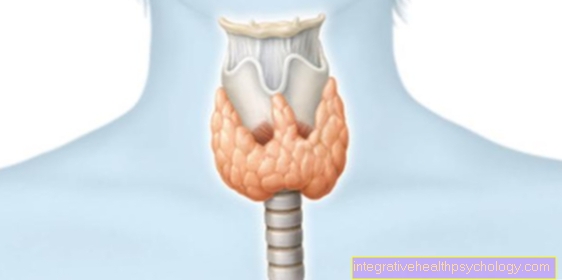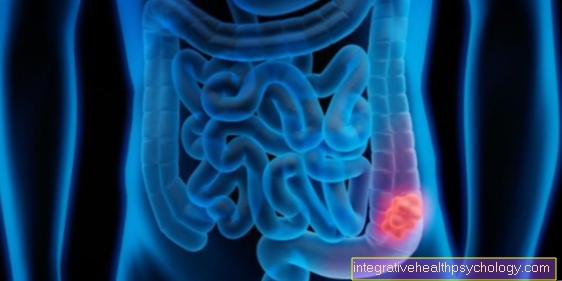Zopiclone
Explanation / definition
Zopiclone is a sleep-inducing drug or, in high doses, a drug that makes you sleep (Hypnotic), which has been approved in Germany since 1994. Zopiclone improves the quality of sleep by shortening the time to fall asleep, lengthening the sleeping time and reducing the time you wake up at night.
Trade names

Optidorm (D)
Zopiclodura (D)
Zopitin (CZ)
Somnal (A)
Somnosan (D)
Imovane (D, CH)
Ximovan (D)
Chemical name
Zopiclone is the only one used as a sedative (sedative) approved Cyclopyrrolone derivative.
Zopiclone is a so-called Z-drug (Z-drug). This means that it is very similar to the effect of the calming benzodiazepines, as the Z-drugs, like the benzodiazepines, bind to the sleep-promoting and calming gamma-aminobutyric acid docking sites (GABA receptors) in the central nervous system.
application areas
Zopiclone is called Sedatives (sedative) and especially for the short-term treatment of Fall asleep- and Difficulty sleeping through the night applied. The sleep aid (hypnotic) also improves the quality of sleep in the sense that it reduces nighttime or very early morning waking.
Due to the generally dampening effect of Zopiclone can also be anti-anxiety (anxiolytic), antispasmodic (anticonvulsant) and muscle relaxing Effects are observed.
Form of administration / application / dosage
Zopiclone in the form of a film-coated tablet is swallowed whole before going to bed and with plenty of fluid (preferably water). The dose (either 3.75 mg or 7.5 mg) is determined individually by the doctor, whereby a daily dose of 7.5 mg is usual for healthy adults. Older or previously ill patients usually start with a daily dose of 3.75 mg.
It is of great importance that when taking zopiclone a sleep duration of at least 7-8 hours should be guaranteed, as the drug negatively affects the ability to react and so e.g. the ability to drive may be severely impaired. Furthermore, the intake of zopiclone without medical advice should not exceed 4 weeks, otherwise there is a risk of addiction.
effect
Zopiclone has an inhibitory effect on the central nervous system. The drug achieves this dampening effect by activating so-called GABA (Gamma aminobutyric acid) - receptors. GABA is the most important inhibiting messenger substance (neurotransmitter) of the central nervous system. Zopiclone can bind to these docking sites (receptors) of GABA and reduce the excitability of the nerve cells through an influx of chloride or even inhibit it completely for some time. The nerve cell is then no longer excitable for some time and incoming stimulus impulses cannot be passed on to the central nervous system.
The maximum plasma concentration (i.e. the highest dose that can be detected in the blood) is already one hour after taking Zopiclone reached. The half-life, i.e. the period in which the concentration in the blood halves, is 5 hours.
side effect
As with all effective drugs, side effects can occur when taking zopiclone.
Most often, patients report one Change in the sense of taste (metallic, bitter) and Dry mouth. Besides that are also nightmares, a headache, Visual disturbances, Feelings of weakness, dizziness, Reduction in performance, as well as a Daytime sleepiness possible side effects when taking zopiclone. In addition, memory or memory gaps can occur after taking the drug (anterograde amnesia) occur. Furthermore, false perceptions (Hallucinations) described.
The physical and psychological aspects should not be underestimated Addictive potential, which mainly consists of the regular and long-term use of zopiclone. Furthermore, after several weeks of regular use of zopiclone, withdrawal symptoms may occur due to the addiction effect after discontinuation. It is therefore of great importance to only take the drug for severe sleep disorders and for a short period of time, and for known addictive disorders to carefully weigh up the intake and, if necessary, first treat the sleep disorder with less potent drugs with lower addictive potential.
interaction
If other sleeping pills or sedatives as well as pain and anesthetic medication are taken at the same time, the depressant effect of the zopiclone may be intensified. Furthermore, drugs for the treatment of mental illnesses lead to muscle relaxation (Muscle relaxants), for seizures (Anti-epileptic drugs) and certain medicines for allergies (Antihistamines) to a stronger damping of the central nervous system. Medicines that reduce the function of the zopiclone-degrading enzyme (Cytochrome P450) inhibit, e.g. Fungal medication (e.g. ketoconazole, itraconazole) or certain antibiotics (e.g. erythromycin, clarithromycin) that increase the effect of the zopiclone.
On the other hand, drugs that activate the zopiclone-degrading enzyme (cytochrome P450) (such as St. John's wort, phenobarbital, carbamazepine or rifampicin) reduce the effect of the zopiclone.
Contraindication
On the one hand, zopiclone should not be used in the event of breathing disorders or known episodes of breathlessness during sleep (Sleep apnea), on the other hand with one Liver failure (Hepatic insufficiency).
Furthermore, zopiclone must not be prescribed for existing or past addictions.
A muscle disease (myastenia gravis) is also a contraindication for taking the drug.
Prescription requirement
Zopiclone is a prescription drug, which should only be prescribed by a doctor and taken for a short period of time.






.jpg)






















